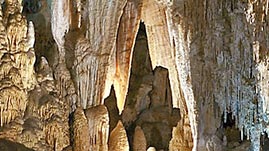Teachers' Domain - Digital Media for the Classroom and Professional Development
User: Preview

Source: National Park Service
Caves are natural cavities that form in hillsides and cliff walls and underground, and are accessible at Earth's surface. There are many different types of caves, including solution caves, tectonic caves, boulder caves, sea caves, and lava tubes. All typically form over thousands of years as a result of natural mechanical and chemical processes in soft, fractured, or soluble rock. This interactive activity adapted from the National Park Service details and depicts caves and other karst features.
Karst landscapes, which are characterized by grooved rock pavements, underground streams, and scattered circular depressions called sinkholes, are formed by the chemical weathering of certain rock types, a process with a rather innocuous instigator: ground water. Although solution caves make up only one percent of karst environments, they are the best-known karst features.
Solution caves almost always form at or below the water table where active underground streams can flow. When the water table drops and the cave opens to the surface, we can see the marvelous air-filled spaces. Solution caves can form in rocks rich in carbonate or sulfate minerals, which dissolve in slightly acidic ground water. Limestone, dolomite, and marble are cave-forming carbonates, and gypsum is a cave-forming sulfate. Carbonate solution caves have the potential to have showy signature formations like stalactites and stalagmites. By contrast, the much rarer sulfate caves do not.
The darkness that characterizes most caves adds to their mystery. The further into a cave one travels from its surface entrance, the darker it gets. Despite the lack of light, caves can be teeming with organisms specially adapted to cope in these conditions. Caves are also very quiet spaces, with noise coming only from air currents and flowing or dripping water.
Unlike surface climates, the climate inside caves is largely controlled. Temperatures remain constant throughout the year, hovering near the annual average surface temperature; any impact from seasonal variation at the surface diminishes the further inside a cave system one travels. Caves with active water supplies tend to have high humidity, which can be visually confirmed by the moisture that collects and drips from ceilings and walls. Because caves are open to the surface, pressure changes outside a cave cause the pressure inside to change, resulting in air currents and an equalization of air pressure.
Karst systems are extremely sensitive to environmental disturbances. Because the integrity of any karst system is dependent on air, water, and land, effective conservation policies provide comprehensive protection of natural airflow, water, and humidity conditions in both caves and their wider catchments.
 Loading Standards
Loading Standards Teachers' Domain is proud to be a Pathways portal to the National Science Digital Library.
Teachers' Domain is proud to be a Pathways portal to the National Science Digital Library.
